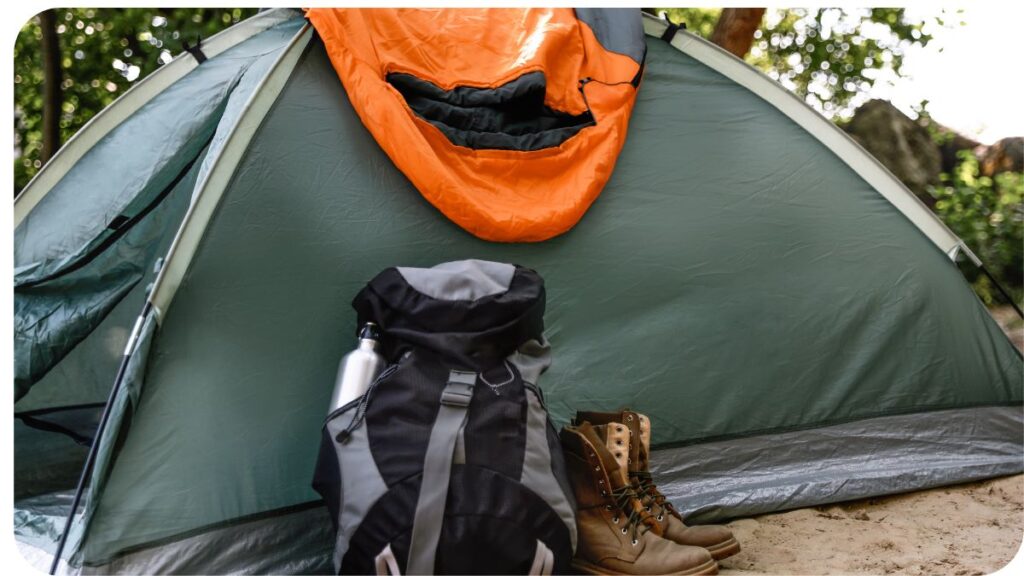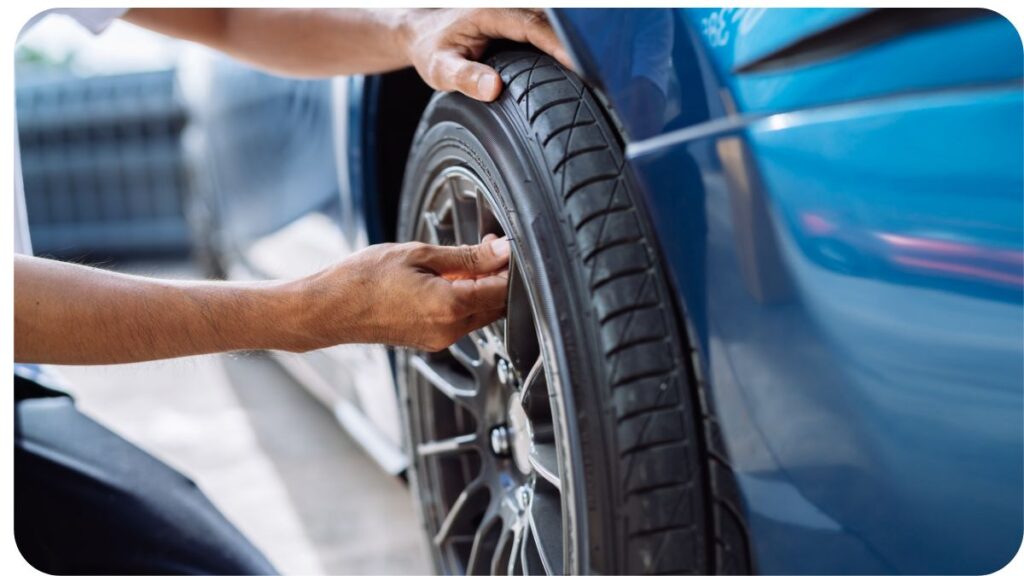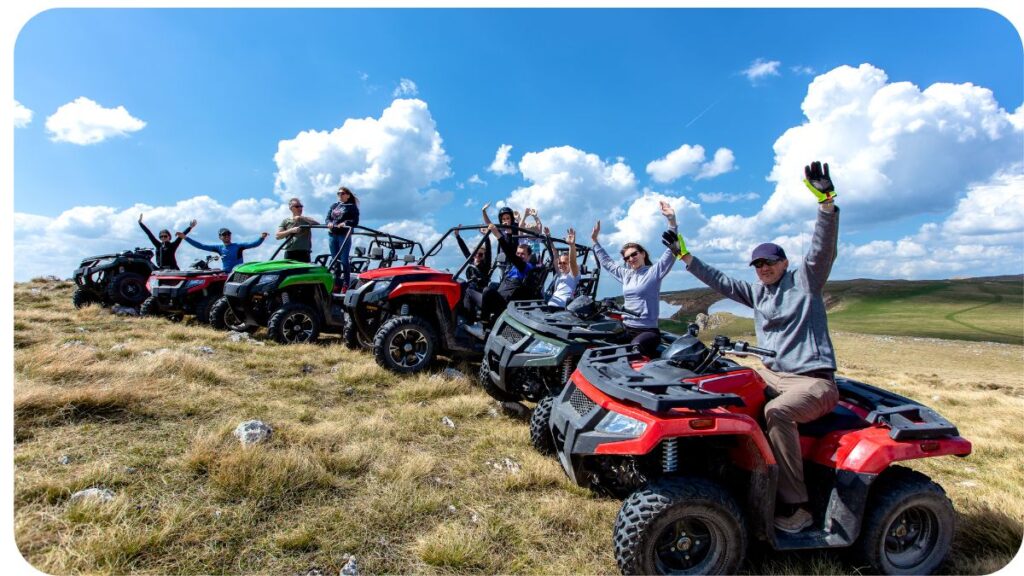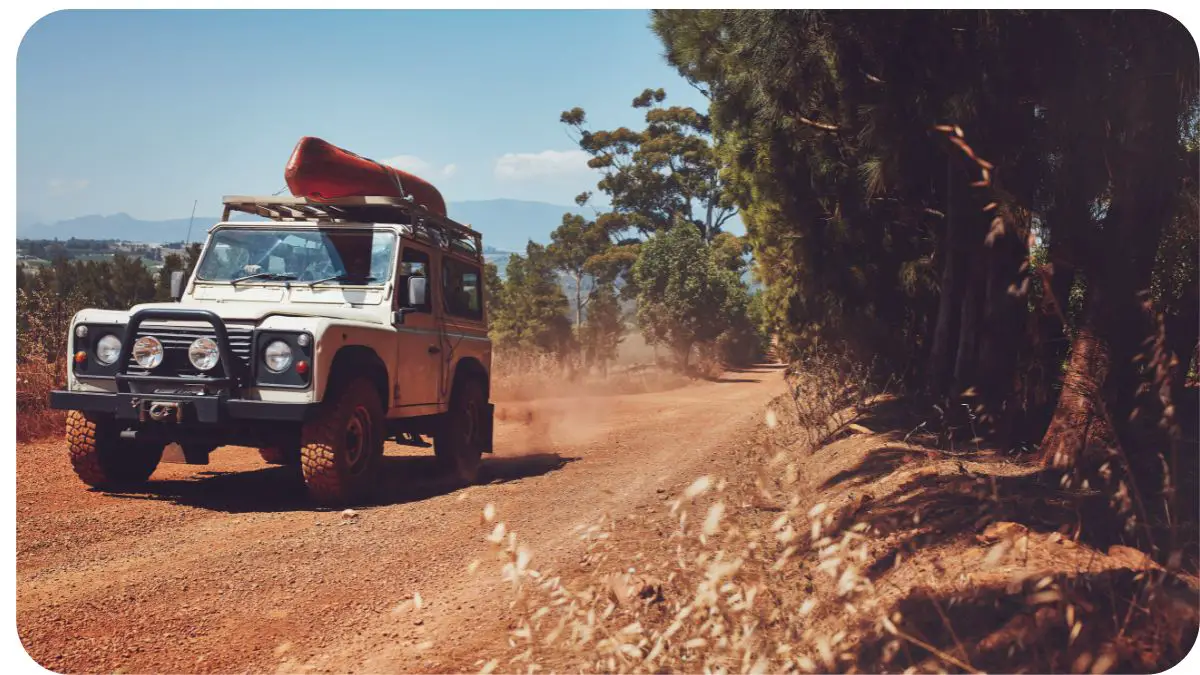Off-road camping is an exhilarating way to connect with nature, but the key to a successful adventure lies in meticulous preparation. Whether you’re a seasoned off-road enthusiast or a beginner, having a comprehensive checklist ensures you’re ready for whatever the wilderness throws your way.
| TakeawayS |
|---|
| 1. Thorough preparation is crucial for a successful off-road camping adventure. |
| 2. Prioritize safety by checking emergency contacts, communication devices, and wildlife awareness. |
| 3. Organize gear efficiently using packing cubes, labeling, and categorizing items for streamlined setup. |
| 4. Consider essential factors for off-road driving success, including terrain handling and vehicle knowledge. |
| 5. Responsible campsite selection, waste management, and wildlife interaction contribute to environmental conservation. |
| 6. Enjoy a campfire responsibly by using designated areas, keeping it small, and following local regulations. |
| 7. Explore further reading for in-depth insights from reputable sources on off-road camping checklists. |
2. Essential Gear
2.1 Tent and Sleeping Bag

When venturing off-road, a reliable tent and sleeping bag are your home away from home. Here’s a table summarizing the essentials:
Selecting the perfect tent is crucial for a comfortable off-road camping experience. Ensure optimal shelter by considering factors like size, weather resistance, and ease of setup.
| Gear | Recommendation |
|---|---|
| Tent | Weather-resistant, easy to set up |
| Sleeping Bag | Suitable for expected temperatures |
| Sleeping Pad | Extra insulation from the ground |
2.2 Portable Cooking Equipment
Preparing meals in the wild requires lightweight, portable gear. Here’s a handy table:
| Equipment | Features |
|---|---|
| Portable Stove | Efficient and easy to use |
| Cookware Set | Lightweight and durable |
| Utensils | Compact and multi-functional |
| Cooler | Keep perishables fresh on the go |
2.3 First Aid Kit
Safety is paramount. Your first aid kit should be comprehensive and easily accessible. Let’s break it down:
| First Aid Supplies | Essential Items |
| Bandages | Assorted sizes for different cuts |
| Antiseptic Wipes | Clean wounds without water |
| Pain Relievers | Over-the-counter medications |
| Tweezers | Remove splinters and ticks |
2.4 Navigation Tools
Getting lost off-road is no joke. Equip yourself with reliable navigation tools:
| Tools | Navigation Essentials |
|---|---|
| Maps | Detailed, waterproof maps |
| Compass | A reliable compass for direction |
| GPS Device | Satellite-guided navigation |
3. Vehicle Preparation
3.1 Tire Check and Spare

Your vehicle is your lifeline on an off-road expedition. Ensure your tires are up to the challenge:
| Checkpoints | What to Inspect |
|---|---|
| Tread Depth | Sufficient for off-road traction |
| Tire Pressure | According to manufacturer’s specs |
| Spare Tire | In good condition and properly inflated |
| Jack and Tools | Functional and suitable for your vehicle |
3.2 Fluid Levels
A well-maintained vehicle is crucial for a trouble-free journey. Keep an eye on essential fluid levels:
| Fluids | Important Levels to Monitor |
|---|---|
| Engine Oil | Check and change as needed |
| Brake Fluid | Ensure it’s at the recommended level |
| Coolant | Prevent overheating on the trail |
| Transmission Fluid | Necessary for smooth gear shifts |
3.3 Suspension and Off-Road Modifications
Off-roading demands more from your vehicle. Consider these modifications:
Embarking on an off-road adventure? Equip yourself with essential gear for a smooth and safe journey. Learn about must-have items to enhance your off-road experience and be prepared for any terrain.
| Modifications | Enhancements for Off-Roading |
|---|---|
| Suspension Lift Kit | Increased ground clearance |
| Skid Plates | Protect vital components |
| Off-Road Lights | Improved visibility at night |
| Winch | Essential for self-recovery |
4. Food and Water
4.1 Meal Planning
A well-fed camper is a happy camper. Plan your meals with variety and simplicity in mind:
| Meal | Planning Tips |
|---|---|
| Breakfast | Quick and energizing options |
| Lunch | Portable and easy to assemble |
| Dinner | One-pot wonders for easy cleanup |
| Snacks | High-energy, non-perishable options |
4.2 Water Filtration
Access to clean water is vital. Consider the following filtration options:
| Filtration Methods | Pros and Cons |
|---|---|
| Portable Filters | Lightweight but require maintenance |
| Water Purification Tablets | Compact and no moving parts |
| Boiling | Effective but requires a heat source |
4.3 Snacks and Emergency Rations
Don’t underestimate the importance of snacks and emergency food:
| Snacks | Trail-Worthy Snack Ideas |
|---|---|
| Trail Mix | A mix of nuts, dried fruits, and chocolate |
| Energy Bars | Convenient and packed with nutrients |
| Jerky | Protein-rich and easy to carry |
| Emergency Rations | Non-perishable meals for unexpected situations |
5. Safety Measures
5.1 Emergency Contacts
Being prepared means having the right contacts at your fingertips:
Transform your off-road vehicle into a versatile powerhouse with comprehensive outfitting tips. Explore modifications, accessories, and expert advice to optimize performance and tailor your ride to meet any off-road challenge.
| Contacts | Essential Numbers |
|---|---|
| Emergency Services | Local police, fire, and medical |
| Roadside Assistance | Contact for vehicle breakdowns |
| Campground or Park Office | Site-specific assistance |
| Trusted Friends or Family | In case of communication failure |
5.2 Communication Devices
Staying connected is crucial, especially in remote areas. Consider these devices:
| Devices | Communication Tools |
|---|---|
| Two-Way Radios | Short-range communication between vehicles |
| Satellite Phone | Emergency communication when out of cell range |
| Personal Locator Beacon | SOS signaling in dire situations |
5.3 Wildlife Awareness
Respecting nature includes understanding and coexisting with wildlife:
| Awareness Tips | Staying Safe in the Wilderness |
|---|---|
| Identify Local Wildlife | Know what to expect in the area |
| Keep a Safe Distance | Avoid approaching or feeding animals |
| Secure Food Storage | Minimize attraction to your campsite |
6. Campsite Selection
6.1 Leave No Trace Principles
Maintain the pristine beauty of your surroundings with Leave No Trace practices:
Off-road enthusiasts, don’t overlook the significance of vehicle insurance for protection on and off the trail. Understand the coverage options and ensure your adventurous spirit is safeguarded with the right insurance plan
| Principles | Respecting Nature While Camping |
|---|---|
| Pack It In, Pack It Out | Take all trash with you |
| Campsite Selection | Choose established sites and avoid fragile areas |
| Proper Waste Disposal | Dispose of waste responsibly |
6.2 Proximity to Water Sources
Convenience meets sustainability when selecting a campsite near water:
| Considerations | Benefits of Proximity to Water |
|---|---|
| Drinking Water Access | Easy access to a vital resource |
| Wildlife Observation | Potential for observing local fauna |
| Cleaning and Cooking | Convenient for campsite activities |
6.3 Terrain Considerations
Understanding the terrain is essential for a comfortable and safe camping experience:
| Terrain Features | What to Look for in Campsite Selection |
|---|---|
| Level Ground | Comfortable sleeping and cooking areas |
| Natural Windbreaks | Protection from strong winds |
| Proximity to Trails | Easy access for hiking and exploration |
7. Packing Tips
7.1 Organizing Gear
Efficiency in packing can make or break your camping trip. Here’s how to organize your gear:
| Packing Tips | Keeping Your Gear in Order |
|---|---|
| Use Packing Cubes | Keep similar items together |
| Label Everything | Easily locate essentials |
| Group by Category | Streamline setup and breakdown |
| Keep Frequently Used Items Accessible | Avoid rummaging for necessities |
7.2 Weight Distribution
Proper weight distribution is crucial for vehicle stability and safety:
| Distribution Tips | Ensuring a Balanced Load |
|---|---|
| Heavier Items Low | Place heavy items at the bottom of the vehicle |
| Secure Loose Items | Prevent shifting during off-road driving |
| Balance Left to Right | Distribute weight evenly on both sides of the vehicle |
| Check Vehicle Capacity | Don’t exceed the recommended weight limit |
7.3 Compactness
Maximize your space without compromising on essentials:
| Compact Packing | Saving Space in Your Vehicle |
|---|---|
| Collapsible Gear | Folding chairs, tables, and cookware |
| Vacuum-Sealed Bags | Compress clothing and bedding |
| Modular Equipment | Items that serve multiple purposes |
8. Weather Preparedness
8.1 Checking Weather Forecast
Nature can be unpredictable, so stay informed:
| Weather Planning | Reliable Sources for Forecast |
|---|---|
| National Weather Service | Accurate and up-to-date information |
| Weather Apps | Real-time updates on your device |
| Backup Communication | In case of loss of electronic devices |
8.2 Adequate Clothing
Dress for success in any weather:
| Clothing Essentials | Being Prepared for Temperature Changes |
|---|---|
| Layered Clothing | Easily adjust to changing temperatures |
| Waterproof Gear | Stay dry during unexpected rain |
| Cold-Weather Accessories | Gloves, hats, and thermal socks |
8.3 Shelter Considerations
Your shelter is your primary defense against the elements:
| Shelter Tips | Ensuring a Comfortable Camp |
|---|---|
| Rainfly for the Tent | Keep dry in wet weather |
| Windproof Features | Sturdy tents for windy conditions |
| Adequate Ventilation | Prevent condensation in the tent |
9. Off-Road Driving Techniques

9.1 Handling Different Terrains
Mastering various terrains is crucial for a safe and enjoyable off-road experience:
Embark on off-road journeys with confidence using expert tips for navigating remote locations. Enhance your skills in handling challenging terrains and make the most of your off-road adventures with practical insights and strategies.
| Terrain Types | Driving Techniques and Tips |
|---|---|
| Mud and Sand | Reduce tire pressure for better traction |
| Rocks and Boulders | Choose the right line and drive slowly |
| Gravel and Dirt Roads | Maintain a steady speed and avoid sharp turns |
9.2 Recovery Equipment
Prepare for the unexpected with the right recovery gear:
| Recovery Gear | Essential Tools for Off-Road Adventures |
|---|---|
| Tow Straps | For towing or getting towed |
| Hi-Lift Jack | Lifting your vehicle out of tough spots |
| Portable Air Compressor | Reinflate tires after off-road driving |
| Traction Boards | Gain traction in soft or muddy terrain |
9.3 Knowing Your Vehicle
Understanding your vehicle’s capabilities is key:
| Vehicle Knowledge | Getting the Most Out of Your Off-Roader |
|---|---|
| Four-Wheel Drive (4WD) | When and how to engage 4WD |
| Ground Clearance | Knowing the limits of your vehicle |
| Brake Control | Braking techniques for downhill slopes |
| Diff Lock | Using differential lock for added traction |
10. Setting Up Camp
10.1 Tent Pitching
A secure and well-pitched tent is essential:
| Tent Setup Tips | Ensuring a Sturdy and Comfortable Shelter |
|---|---|
| Clear the Site | Remove rocks and debris before pitching |
| Proper Staking | Use sturdy stakes for stability |
| Rainfly Placement | Ensure proper coverage for rainy weather |
| Ventilation | Prevent condensation inside the tent |
10.2 Campfire Safety
Enjoying a campfire responsibly is an art:
| Campfire Tips | Enjoying a Safe and Cozy Campfire |
|---|---|
| Use Designated Areas | Follow campground or park regulations |
| Keep it Small | Contain the fire to a manageable size |
| Extinguish Completely | Put out the fire before leaving camp |
| Respect Fire Bans | Adhere to any fire restrictions in the area |
10.3 Creating a Comfortable Sleeping Area
A good night’s sleep is essential for a successful off-road adventure:
| Sleeping Comfort | Tips for a Restful Night’s Sleep |
|---|---|
| Quality Sleeping Bag | Match it to the expected temperature |
| Inflatable Mattress | Added comfort for a good night’s sleep |
| Ambient Lighting | Soft lighting for a relaxed atmosphere |
| Earplugs | Minimize noise disturbances |
11. Navigation and Orientation
11.1 Maps and GPS Devices
Navigating off-road requires the right tools:
| Navigation Tools | Choosing the Best for Your Adventure |
|---|---|
| Topographic Maps | Detailed maps for terrain understanding |
| GPS Unit | Reliable and durable GPS device |
| Smartphone Apps | GPS apps for real-time navigation |
| Compass | A backup for electronic navigation |
11.2 Landmarks and Waypoints
Useful navigation involves recognizing key points:
| Landmarks and Waypoints | Marking Your Route on the Trail |
|---|---|
| Natural Features | Mountains, rivers, and distinctive trees |
| Man-Made Structures | Buildings, bridges, or unique signs |
| GPS Waypoints | Precise locations for navigation |
| Trail Markings | Follow trail markers for guidance |
11.3 Night Navigation Tips
Navigating at night requires additional considerations:
| Night Navigation | Staying on Course After Dark |
|---|---|
| Headlamp | Hands-free illumination for the trail |
| Reflective Markers | Mark your path for easy identification |
| Night Vision | Allow your eyes to adjust to low light |
| Slow and Steady | Proceed with caution in the dark |
12. Wildlife Interaction
12.1 Respectful Observation
Appreciate wildlife from a safe distance:
| Observing Wildlife | Enjoying Nature Responsibly |
|---|---|
| Binoculars | Close-up views without disturbance |
| Quiet Movement | Avoid sudden noises or fast movements |
| Do Not Feed Wildlife | Maintain their natural behaviors |
| Wildlife Etiquette | Follow guidelines for responsible viewing |
12.2 Food Storage Best Practices
Minimize the risk of attracting unwanted guests:
| Food Storage Tips | Protecting Your Supplies from Wildlife |
|---|---|
| Bear Canisters | Secure storage for bear-prone areas |
| Hanging Food Bags | Keep food out of reach of ground animals |
| Sealed Containers | Prevent odors from attracting wildlife |
| Cooking Away from Camp | Minimize food smells near sleeping areas |
12.3 Dealing with Unwanted Visitors
Know what to do if wildlife encroaches on your campsite:
| Unwanted Visitors | Safely Handling Unexpected Encounters |
|---|---|
| Make Noise | Deter animals with loud sounds |
| Back Away Slowly | Create space without startling wildlife |
| Use Bear Spray | A last resort for bear encounters |
| Report Aggressive Behavior | Inform local authorities about concerning wildlife |
13. Campfire Cooking
13.1 Essential Cooking Utensils
Cooking over a campfire can be a rewarding experience with the right tools:
| Cooking Utensils | Must-Have Items for Campfire Cooking |
|---|---|
| Cast Iron Skillet | Versatile for various recipes |
| Grilling Grate | Perfect for cooking over an open flame |
| Dutch Oven | Ideal for slow-cooking and baking |
| Cooking Utensil Set | Spatula, tongs, and a stirring spoon |
13.2 Campfire Recipes
Turn your campfire into a culinary delight:
| Campfire Recipes | Simple and Delicious Outdoor Meals |
|---|---|
| Foil Packet Dinners | Easy prep and minimal cleanup |
| One-Pot Stews | Hearty meals with minimal effort |
| Grilled Vegetables | Healthy and flavorful side dishes |
| S’mores Variations | Creative twists on a classic treat |
13.3 Fire Safety
Enjoying a campfire responsibly includes fire safety measures:
| Fire Safety Tips | Preventing Accidents at the Campfire |
|---|---|
| Clear the Area | Remove flammable materials around the fire pit |
| Keep a Water Source | Have water nearby for emergencies |
| Extinguish Completely | Put out the fire before leaving the campsite |
| Follow Local Regulations | Adhere to fire restrictions in the area |
14. Waste Management
14.1 Proper Disposal of Trash
Maintaining a clean campsite is everyone’s responsibility:
| Waste Disposal Tips | Keeping the Wilderness Pristine |
|---|---|
| Pack Out All Trash | Leave no litter behind |
| Separate Recyclables | Dispose of recyclables properly |
| Compost Organic Waste | Minimize your environmental impact |
| Follow Leave No Trace | Adhere to the principles of outdoor ethics |
14.2 Eco-Friendly Toiletry Options
Make sustainable choices even in the backcountry:
| Toiletry Tips | Minimizing Your Environmental Impact |
|---|---|
| Biodegradable Soap | Choose soap that breaks down naturally |
| Reusable Toiletry Kit | Refillable containers for personal care |
| Use Portable Toilets | Pack out human waste in designated bags |
| Bury Human Waste | Follow Leave No Trace guidelines for waste disposal |
14.3 Portable Toilet Considerations
When nature calls, be prepared:
| Portable Toilet Tips | Choosing and Using a Portable Toilet |
|---|---|
| Types of Portable Toilets | Chemical, composting, and bag systems |
| Proper Disposal | Dispose of waste according to regulations |
| Privacy Shelter | Maintain privacy at your campsite |
| Sanitizing Supplies | Keep your portable toilet clean and hygienic |
15. Conclusion
15.1 Recap of Checklist
Embarking on an off-road camping trip requires thorough preparation. Let’s summarize the essential checklist:
| Checklist Categories | Key Considerations |
|---|---|
| Essential Gear | Tent, sleeping bag, cooking equipment, and first aid kit |
| Vehicle Preparation | Tire check, fluid levels, and off-road modifications |
| Food and Water | Meal planning, water filtration, and emergency rations |
| Safety Measures | Emergency contacts, communication devices, and wildlife awareness |
| Campsite Selection | Leave No Trace principles, proximity to water sources, and terrain considerations |
| Packing Tips | Organizing gear, weight distribution, and compact packing |
| Weather Preparedness | Checking weather forecasts, adequate clothing, and shelter considerations |
| Off-Road Driving Techniques | Handling different terrains, recovery equipment, and knowing your vehicle |
| Setting Up Camp | Tent pitching, campfire safety, and creating a comfortable sleeping area |
| Navigation and Orientation | Maps, GPS devices, landmarks, and waypoints |
| Wildlife Interaction | Respectful observation, food storage best practices, and dealing with unwanted visitors |
| Campfire Cooking | Essential utensils, campfire recipes, and fire safety |
| Waste Management | Proper disposal of trash, eco-friendly toiletry options, and portable toilet considerations |
15.2 Encouragement for Off-Road Adventures
Armed with this comprehensive checklist, you’re well-equipped for an unforgettable off-road camping experience. Remember, each adventure is unique, so adapt this checklist to suit your specific needs and preferences. Embrace the joy of the journey, stay safe, and enjoy the wonders of the great outdoors.
Happy off-roading!
Further Reading
For more in-depth information and additional insights on preparing for off-road camping, check out these valuable resources:
- The Ultimate Off-Road Camping Checklist
- Explore TJM’s comprehensive guide covering essential gear, vehicle preparation, safety measures, and more to ensure a successful off-road camping trip.
- 4×4 Off-Road Checklist – Arrive Alive
- Arrive Alive provides a thorough 4×4 off-road checklist, emphasizing safety measures and vehicle considerations for a secure and enjoyable off-road adventure.
- What Do I Need for an Off-Road Camping Trip?
- Trayon’s blog offers valuable insights into the essential items required for off-road camping, with a focus on practical tips and gear recommendations.
FAQs
What should be my top priority when preparing for an off-road camping trip?
Ensuring the safety of yourself and others should always be the top priority. Double-check your emergency contacts, communication devices, and wildlife awareness to minimize risks.
How do I choose the right campsite for off-road camping?
Consider factors such as leave-no-trace principles, proximity to water sources, and terrain considerations when selecting a campsite. Following these guidelines will help you find a suitable and eco-friendly location.
Is there a recommended way to organize and pack my camping gear efficiently?
Yes, organizing gear is crucial. Use packing cubes, label everything, and group items by category to streamline the setup and breakdown process, making your off-road adventure more enjoyable.
What are the key factors to consider when driving off-road?
Handling different terrains, having the right recovery equipment, and understanding your vehicle’s capabilities are essential factors for a successful off-road driving experience.
How can I enjoy a campfire responsibly during my off-road camping trip?
To enjoy a campfire responsibly, use designated areas, keep the fire small, extinguish it completely before leaving, and always follow local regulations to prevent accidents and protect the environment.

Hi there! I’m Hellen James, and I’m the author of Unified Off-roads. I’ve been driving off-road for more than ten years, and I’ve had a lot of fun in that time—and a few not-so-great experiences too. But I’ve always wanted to help other people get started off-roading, so I decided to start this blog to share my knowledge with others.


